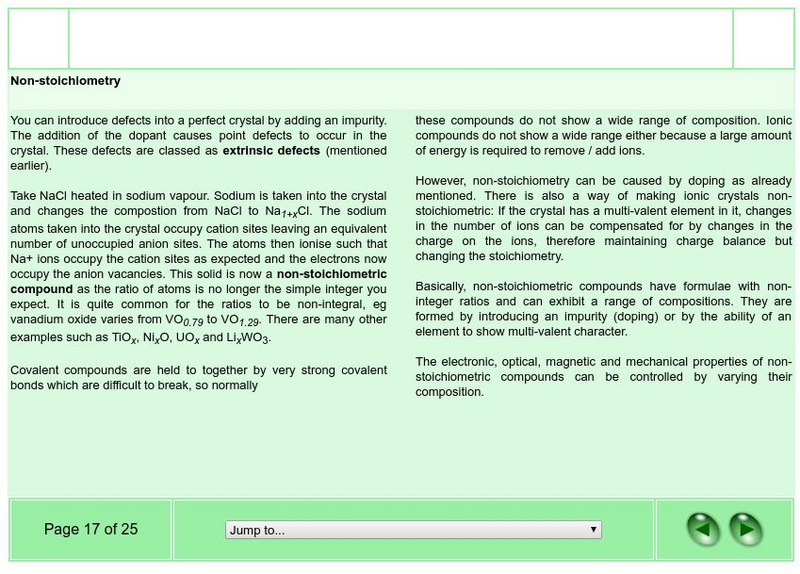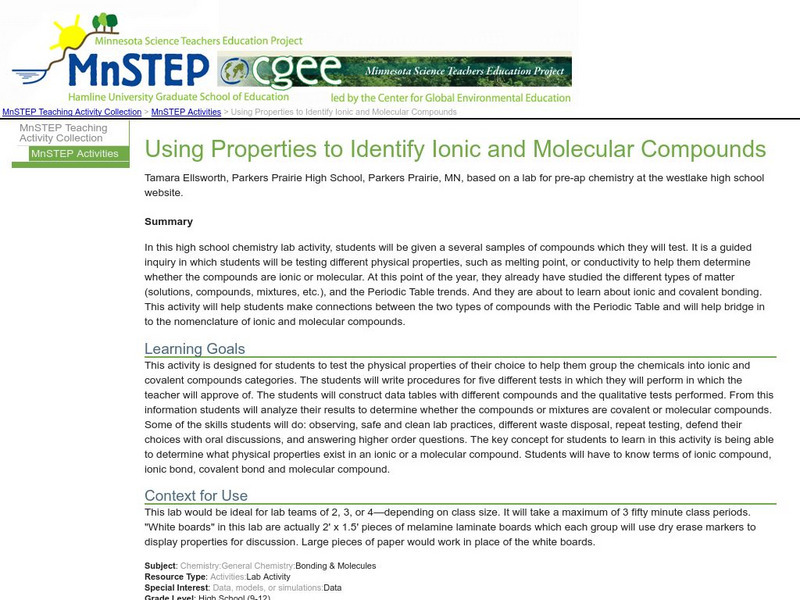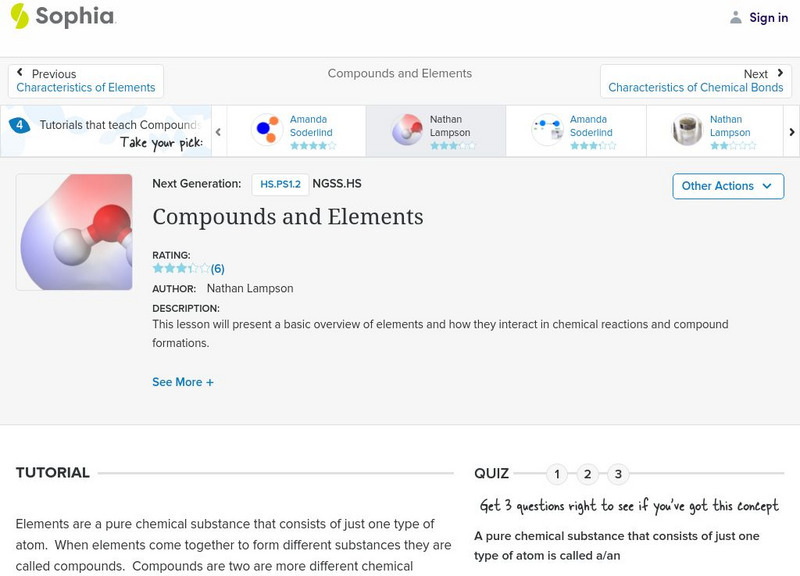University of Oxford (UK)
University of Oxford: Solid State Chemistry: Non Stoichiometry
Discover what makes a non-stoichiometric compound.
Science Education Resource Center at Carleton College
Serc: Using Properties to Identify Ionic and Molecular Compounds
A guided inquiry in which students test different physical properties, such as melting point or conductivity, to help them determine whether the compounds are ionic or molecular.
Simon Fraser University
Chem1 Virtual Textbook: Chemical Composition
Chemical composition is a section of a larger overview on Chemistry, covering a variety of aspects. This section focuses on elements, atoms, compounds, and structure. Examples, formulas, and pictures are provided.
Crescent Public Schools
The Internet Science Room: Chemical Formulas
This illustrated tutorial serves as a foundation for understanding chemical formulas in chemistry.
Crescent Public Schools
The Internet Science Room: Naming Chemical Formulas
Students can use this chemistry tutorial to help them understand how to name chemical formulas.
Open Curriculum
Open Curriculum: Matter
Students will be able to describe elements and compounds, and explain how mixtures differ from compounds.
Other
Science Alive: Synthetic vs. Natural: What's the Difference?
Through this reading, young scholars will learn that a substance's properties arise from its molecular structure, not from how it's made (i.e., synthesized by people or found in nature). There is no fundamental difference between natural...
Other
Science Alive: The Many Faces of Steroids
This reading is an introduction to the great variety of steroids and their many different uses.
Other
Fernbank: Naming Chemical Compounds
Learn how to name chemical compounds. Scientist world over use a standard method for naming chemical compounds based on an international standard that makes working with chemicals not only precise but safe as well. Includes quiz.
State University of New York
State University of New York: Compounds, Molecules, and the Mole
This simulation explores the relationship between mass, moles, molecules and atoms. Select one of the 6 compounds, set the mass of the compound, and release the scrollbar to calculate.
Other
Bell Laboratories: Colloids
This site is provided by Bell Laboratories, and is devoted to the mixture known as Colloids. The site is broken down into 4 areas: an intro, what it is, breakthrough, and application section. The site contains pictures and provides many...
Sophia Learning
Sophia: Chemical Reactions: Lesson 4
This lesson will present a basic understanding of the periodic chart of elements and how to predict chemical reactions based on given information. It is 4 of 9 in the series titled "Chemical Reactions."
Sophia Learning
Sophia: Compounds and Elements: Lesson 2
This lesson will present a basic overview of elements and how they interact in chemical reactions and compound formations. It is 2 of 4 in the series titled "Compounds and Elements."
CPALMS
Florida State University Cpalms: Florida Students: Atoms Make Up Everything
Learn how atoms are the building blocks of all living and nonliving things.
CK-12 Foundation
Ck 12: Biology: Significance of Carbon
[Free Registration/Login may be required to access all resource tools.] Describes the significance of carbon to life on Earth.
CK-12 Foundation
Ck 12: Chemistry: Noble Gases
[Free Registration/Login may be required to access all resource tools.] Covers electronic configuration of noble gases and the reactivity of noble gases.
CK-12 Foundation
Ck 12: Plix Series: Percent Composition
[Free Registration/Login Required] Manipulate graph data to see a representation of the percent composition of different compounds. Then answer a challenge question about the activity.
CK-12 Foundation
Ck 12: Chemistry: Compounds
[Free Registration/Login may be required to access all resource tools.] Covers compounds and chemical change.
CK-12 Foundation
Ck 12: Physical Science: Compounds
[Free Registration/Login may be required to access all resource tools.] Explores compounds and their properties, the elements that form them, and their structure.
CK-12 Foundation
Ck 12: Physical Science: Compounds
[Free Registration/Login may be required to access all resource tools.] Investigates compounds and their properties, the elements that form them, and their structure.
Soft Schools
Soft Schools: Chemistry Quizzes: Mixtures and Compounds
Assess your knowledge of mixtures and compounds and your ability to identify real-world examples with this interactive multiple choice quiz. Immediate feedback is provided.
Science Struck
Science Struck: What Is Solvent Extraction and Why Is It Important?
Discusses the importance of solvent extraction, provides examples, looks at the importance of appropriate solvent selection, describes the conditions needed for extraction, and explains some of the methods used.
Frostburg State University
General Chemistry Online: Common Compound Library
Search any of the common compounds in this comprehensive compilation and identify their properties.




















